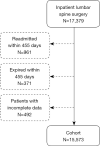Lumbar spine surgery reduces postoperative opioid use in the veteran population
- PMID: 36605994
- PMCID: PMC9808105
- DOI: 10.21037/jss-22-50
Lumbar spine surgery reduces postoperative opioid use in the veteran population
Abstract
Background: The United States has been facing a worsening opioid epidemic over the past two decades. The veteran population represents a large and vulnerable group with a higher burden of mental health comorbidities. The purpose of this study was to analyze the impact of lumbar spine surgery on postoperative opioid usage in the United States veteran population.
Methods: A retrospective cohort study was conducted using the Veterans Affairs Informatics and Computing Infrastructure database. Patients who underwent lumbar spine surgery were stratified into three groups by their preoperative opioid claims within 365 days of surgery. Postoperative cumulative morphine milligram equivalents (MME) were tracked for each group and the paired Wilcoxon signed rank test was used to compare cumulative preoperative MME (days -365-0) to cumulative postoperative MME (days 91-455).
Results: At one year, 30.6% of patients in the high preoperative opioid group and 73.1% of patients in the low preoperative opioid group were no longer using opioids. In the opioid naive cohort, 10.0% of patients were still using opioids at one year. Among all patients, median cumulative postoperative MME was significantly less than median cumulative preoperative MME (P<0.001). High preoperative opioid usage of more than 3 claims was most significantly associated with continued postoperative opioid usage (odds ratio 12.55, P<0.001). From 2010 to 2020 the proportion of patients with preoperative opioid claims decreased (58.8% to 34.8%).
Conclusions: In the veteran population, lumbar spine surgery was effective in getting 50% of patients who were on opioids preoperatively to discontinue opioids postoperatively. Even minimal exposure to opioids preoperatively resulted in a 2.69-time increase in risk of being on opioids at one year versus opioid naive patients. This study affirms that despite being a high-risk population, the veteran population has a similar response to lumbar spine surgery as the general population in regards to opioid dependence.
Keywords: Veterans; complications; lumbar; opioid; spine.
2022 Journal of Spine Surgery. All rights reserved.
Conflict of interest statement
Conflicts of Interest: All authors have completed the ICMJE uniform disclosure form (available at https://jss.amegroups.com/article/view/10.21037/jss-22-50/coif). MC is a paid speaker for Medtronic, Stryker and ATEC. The other authors have no conflicts of interest to declare.
Figures



Comment in
-
Opioid prescriptions in a veteran population undergoing lumbar spine surgery: what are the current knowledge gaps?J Spine Surg. 2023 Mar 30;9(1):6-8. doi: 10.21037/jss-22-120. Epub 2023 Feb 9. J Spine Surg. 2023. PMID: 37038419 Free PMC article. No abstract available.
-
The opioid crisis as it pertains to spine surgery.J Spine Surg. 2023 Mar 30;9(1):9-12. doi: 10.21037/jss-22-107. Epub 2023 Jan 4. J Spine Surg. 2023. PMID: 37038425 Free PMC article. No abstract available.
References
-
- Drug Overdose Deaths in the U.S. Top 100,000 Annually [Internet]. 2021 [cited 2022 Jun 2]. Available online: https://www.cdc.gov/nchs/pressroom/nchs_press_releases/2021/20211117.htm
LinkOut - more resources
Full Text Sources
Miscellaneous
